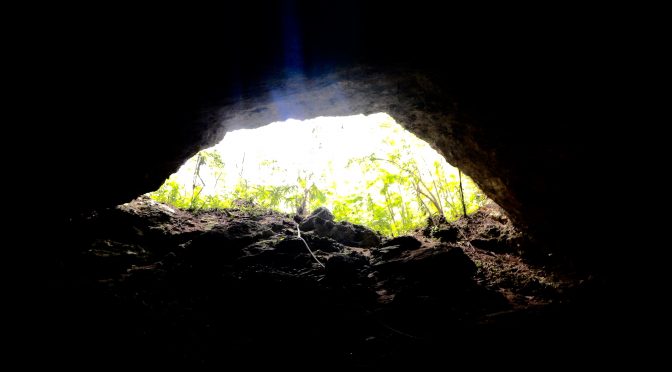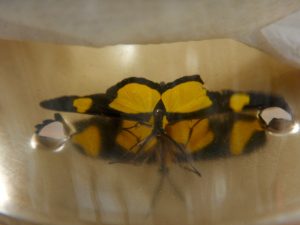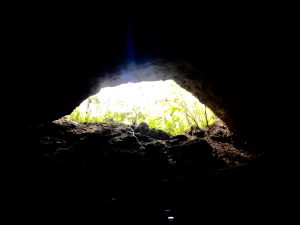
Our last sunset from Las Cuevas
Our last day in the Chiquibul Forest started with a 5 am hike over some extremely steep paths that were still wet from yesterday’s rain. The leaves, tree roots, and mossy rocks were so slick, and I took two nasty spills – I landed on a tree root with my left butt cheek. Despite my searing leg muscles and the blossoming bruises on my butt, the view from the top of Bird Tower was worth the strenuous uphill hike. The sun was still low in the sky, and the forest still seemed to be waking up. Mist rolled in across lush montane forests as far as the eye could see. It was breathtaking – both literally and figuratively.
 View from the top of Bird Tower.
View from the top of Bird Tower.
After breakfast, we set out for another long trek to retrieve our camera traps that we set on our first day at Las Cuevas. The hike was long, but the forest here is so inherently beautiful that I didn’t mind the sweat, sore muscles, and countless bug bites. I caught this strange goldenrod-colored butterfly that was bobbing along San Pastor road:


As per usual, every single blue morpho butterfly that we saw flew out of my reach. I’m very, very sad that I haven’t managed to catch Belize’s most iconic butterfly on this trip, but I guess it just means that I have to come back someday to finish my mission!
In the afternoon, we dug up a couple of leaf cutter nests to examine them from the inside. Scott, our resident ant expert, located the queen of a smallish nest for us, as well as the ants’ fungus garden in which they grow their food. The excavation was great exercise, but the ants that we uncovered were definitely not happy with us.
 I got bitten by a mosquito right in the middle of my forehead as I was excavating the nest. Here’s Elena helping me put Cortisone on the largest bump in the history of ever.
I got bitten by a mosquito right in the middle of my forehead as I was excavating the nest. Here’s Elena helping me put Cortisone on the largest bump in the history of ever.
Finally, the moment we’ve all been waiting for – the checking of the camera traps. I don’t think any of us expected to actually find anything. Maybe a peccary or two if we were lucky. See, as loud, clunky humans that make huge amounts of noise as we travel along the trails, any mammals in the area were aware of our presence before we could even come close to spotting them. By this point in the trip, spotting large mammals in the Chiquibul seemed equivalent to seeing a unicorn.
But.
In the very first trap! A tapir! And a magnificent jaguar, in perfect profile! Right there in the first trap, we captured two of the mammals that we most wanted to see. It only got better and better as we opened the rest of the traps. Of course, not all yielded anything, but most captured at least one or two animals. We saw so many peccaries – nine total.
We also saw a few curassows, two pumas, a coatimundi (kind of like a mix between a raccoon and a red panda), a coral snake, and a 9-banded armadillo. It was truly wild. When the first jaguar appeared on screen, all of us started screaming our heads off – spotting a jaguar is like the mother of all animal sightings in the Chiquibul.
But that wasn’t all! We saw not one, but TWO jaguars in our traps. Practically unheard of!! The big cats were of stocky, muscular build, and had intricate rosette patterning on their hide. I’m still in awe of them and I don’t think I’ll ever get tired of looking at these pictures.
What a satisfying end to our stay at Las Cuevas and the Chiquibul Forest. It’s been an amazing, eye-opening experience. I can truly say that I’ve fallen in love with this place – chiggers, ticks, and all. I’m sad to leave tomorrow morning, but look forward to experiencing the reef.






 Unidentified diurnal moth.
Unidentified diurnal moth. View from the inside of the cave.
View from the inside of the cave.




 View from the top of Bird Tower.
View from the top of Bird Tower.

 I got bitten by a mosquito right in the middle of my forehead as I was excavating the nest. Here’s Elena helping me put Cortisone on the largest bump in the history of ever.
I got bitten by a mosquito right in the middle of my forehead as I was excavating the nest. Here’s Elena helping me put Cortisone on the largest bump in the history of ever.





 Helmeted iguana
Helmeted iguana
